Cleaning up after chlorpyrifos

It’s been big business since its launch more than 50 years ago, but the reign of chlorpyrifos as the world’s most widely used pesticide is finally drawing to an end.
Chlorpyrifos is an organophosphate insecticide sprayed widely on fruits, nuts, beans, and vegetable crops, as well as non-agricultural land such as golf courses, across the USA and the wider world. The US Environment Protection Agency (EPA) estimates that around six million pounds of the chemical was sprayed on roughly 10 million acres of American land, and in more than 40 states, between 2009 and 2013.
This summer, however, the EPA ended years of inaction by revoking all safe tolerances for the amount of chlorpyrifos on food – effectively banning its use on US food crops. This move followed the European Union (EU) decision in January 2020 to prohibit the sale and use of all chlorpyrifos- and chlorpyrifos-methyl-based plant protection products. In November 2020, the EU also set its Maximum Residue Limit for chlorpyrifos in many foods at 0.01mg/kg.
Chlorpyrifos and human health
Chlorpyrifos was first introduced in 1965, and increased in popularity after the endocrine disrupting chemical DDT - itself a replacement for toxic lead arsenate – was banned from the early 1970s. However, in the pattern known as ‘regrettable substitution’, chlorpyrifos was later found to be a neurotoxin, and associated with problems in children’s brain development. The pesticide has been edging towards the exit door since at least 2000, when the EPA negotiated a deal with its manufacturer to phase out its use in household products – but left more profitable agricultural applications intact.
Ironically, the 2000 part-ban played a part in the scientific case against agricultural chlorpyrifos. Because the new arrangements came into effect at the same time as researchers at Columbia University were recruiting participants for a trial on childhood development, it allowed the study group to be divided into two neat halves: those who were exposed to household chlorpyrifos during pregnancy and those who were not. The study ultimately found that children exposed in the womb tended to be smaller, have poorer reflexes, and be more at risk of low IQ, ADHD and other developmental disorders. These conclusions were later endorsed by a number of peer-reviewed publications, including one by researchers at the University of California, Berkeley. The risks to human health – particularly to children and farmworkers - were also cited by both the EU and the EPA in their decisions to ban chlorpyrifos from food use. However, the US ruling does still allow products containing chlorpyrifos to be employed in non-food settings and on cattle ear tags.
EXPLORE OUR CHLORPYRIFOS RANGE
Dr Ehrenstorfer offers an extensive range of reference materials to support your detection of chlorpyrifos and other major organophosphate pesticides in soil, food, water and the fast-growing cannabis sector. Our portfolio includes standards for EPA 500 Series methods as well as mixtures conforming to cannabis pesticide regulations in six US states. As part of the LGC Group, we can also offer you the opportunity to participate in the AXIO Proficiency Testing AQUACHECK scheme for the detection of pesticides in water. For 40 years, AXIO has been a trusted partner for laboratory professionals working to keep the environment safe for everyone.
|
According to the National Pesticide Information Center, chlorpyrifos kills insects upon contact by affecting the normal function of the nervous system, specifically inhibiting the breakdown of the neurotransmitter acetylcholine (ACh). When insects are exposed, chlorpyrifos binds to the active site of the cholinesterase (ChE) enzyme, which prevents breakdown of ACh in the synaptic cleft. The resulting accumulation of ACh causes overstimulation of the neuronal cells, leading to neurotoxicity and death. As an organophosphate, chlorpyrifos belongs to the same class of chemicals as Sarin gas and, although much less potent, is similar in the way that it works and the kind of harmful effects it causes. It is also very toxic to birds, quite toxic to fish, and moderately toxic to humans. At high doses, however, such as those farm workers are exposed to when spraying pesticides, it can cause people to experience nausea, dizziness, and confusion.
The number of regulated pesticides runs into the hundreds – with huge numbers of Maximum Residue Limits (MRLs) linked to hundreds of individual uses – dealing with so many analytes has become a major headache for chemists.
It’s precisely this problem that LGC’s Dr Ehrenstorfer Smart Solutions PestiMix was designed to solve. The PestiMix kit, accredited to ISO 17034, offers a quick and easy solution to enable prompt calibration and spiking of a large number of pesticide analytes. The first product in the series – PestiMix v700 – features the largest mix of pesticide analytes to be found anywhere on the market, combining 745 analytes for liquid chromatography in just five ampoules. These solutions can be combined in just three minutes to create a single solution of 745 analytes at 1ppm. Calibration, meanwhile, takes just 30 minutes, optimising a laboratory’s efficiency and analytical performance.

